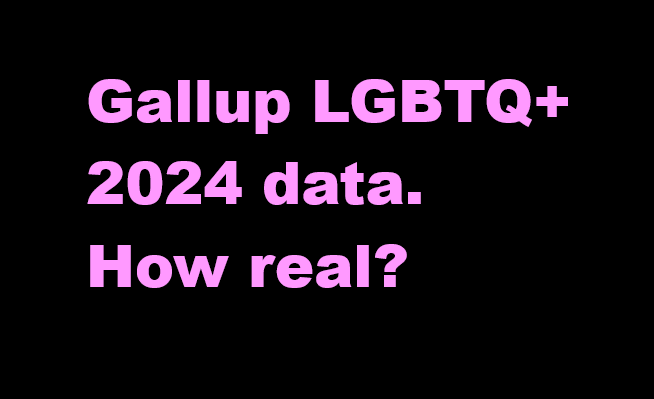Not revealing the data, the Gallup 2024 LGBTQ+ Identification poll results. This is the post that got me banned.
When it doesn't support the narrative, it seems the data isn't released.
Subscriptions are free.
Help me get the word out, share with your social media.
Report on being banned at the end of this post.
The Gallup 2024 results, not what they seem.
Gallup, Feb. 20, 2025, “LGBTQ+ Identification in U.S. Rises to 9.3%.
LGBTQ+ is a grab bag of different items, so saying that it is 9.3% isn’t very informative. One very key set of information is missing.
You don’t know by age and sex in which groups this increase is occuring. Lots of statistics are thrown at you that create different impressions. However, reviewing the Gallup results of 2023, shows you the key gap in the information in the 2024.
This is the link for the 2024 info released this year.
https://news.gallup.com/poll/656708/lgbtq-identification-rises.aspx
Looking at the Gallup 2023 results shows what the 2024 results are not showing.
This is the Gallup report of March 13, 2024.
https://news.gallup.com/poll/611864/lgbtq-identification.aspx
My review of the data Feb. 21, 2025.
In 2023 they had a table of LGBTQ+ Identity, by Gender and Generation, 2023.
What becomes very clear is that the rise to 7.3% in 2023 is largely young women who have decided they are bisexual, and a few that have decided they are asexual.
The increase among men is less, but it is men deciding they are bisexual.
Some commentators pointed out that a lot of the women who were bisexual, actually haven’t had a relationship or dated a woman.
In the 2024, report this table, by gender and age, was omitted.
I have looked and I don’t see where the data can be found.
However, Newsweek reported that the 2025 increase was largely bisexual women.
https://www.newsweek.com/bisexual-women-are-driving-rise-lgbtq-adults-us-2034041
Few were willing to challenge the triumphalism of the 2023 poll results, but some did.
Globe and Mail, May 25, 2024, “‘Going both ways’: Young women are increasingly identifying as bisexual, but what does that mean?”
Are we witnessing the inevitable result of a more open society, with more people able to be who they really are? Or are these a bunch of straight women who fancy themselves more interesting, or more politically enlightened, than the square suburbanite that the phrase “straight woman” evokes?
Some are making the case that it’s the latter. The culture writer Katherine Dee posted on X, in response to the Gen Z female bisexuality findings: “This is a meaningless difference unless it’s reflected in their behaviour, not just their identification habits. Ask me how many bisexual friends I have who haven’t so much as seen another woman naked, forget had sex with one. Keep it moving.” Ms. Dee has written about the way that some young people have started to view sexual orientation labels as less about what you’re doing, with whom, in the flesh, than as claims of affinity or belonging – “More internet-based and therefore disembodied.”
Some may be finding their identity rooted in post-#MeToo sensibilities – that it is unseemly for a woman to need a man. But more of it is, I think, an internalization of the now decades-long drumbeat of supposed science on how women are inherently bisexual. The regularly issued proclamations that all women are bi always feel a bit too convenient. Even if couched in terms of queer liberation, the all-women-are-a-bit-bi theory has a way of winding its way back to business as usual. (Not least because it suggests lesbians are secretly open to dating men.)
Identities are self-reported. We don’t actually measure sexual orientation objectively. The issue is raised whether it is just social contagion.
This is a rather indepth report, but has a summary.
Some excerpts.
The most popular LGBT identity is bisexual, which is significantly more common among women than men.
When we look at homosexual behavior, we find that it has grown much less rapidly than LGBT identification. Men and women under 30 who reported a sexual partner in the last five years dropped from around 96% exclusively heterosexual in the 1990s to 92% exclusively heterosexual in 2021. Whereas in 2008 attitudes and behavior were similar, by 2021 LGBT identification was running at twice the rate of LGBT sexual behavior. [Boldface added.]
Other bullet points strongly suggest perhaps that identifying as bisexual is an ideological statement rather than these women actually doing anything sexual with another woman. Same thing for the men.
I suspect that the ommissionof the table of by gender and age, was omitted to prevent critical analysis of the 2024 poll results recently released as was done with the 2023 poll results.
Some thoughts - LGBTQ+ is a vehicle to submerge Gay and Lesbian concerns.
Gays and Lesbians have real communities, lives and as individuals and a community have real needs and concerned.
LGBTQ+ initialism and cosplaying being bisexual means that our communities are colonized by those playing games or wanting to make an ideological statement. It allows our needs to be buried or submerged.
It also means that institutions and organizations will be concerned with these cosplayers.
We need to have specifically Gay organization and specifically Lesbian organizations.
We also need to be very skeptical of any statements about LGBTQ+, because the initialism is an instrument to obscure and misdirect.





